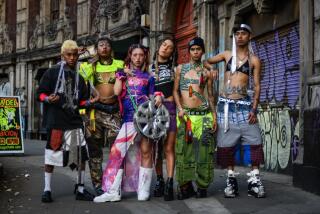Tijuana Puts the Wraps on San Diego Artist’s Unflattering Look at Tourism
- Share via
A San Diego artist’s unflattering look at tourism stereotypes in Tijuana has proved so controversial that officials at Centro Cultural de Tijuana edited out a large section of the work before displaying it in an exhibit that opened there Sunday.
“It is as if the Centro decided to rip a photograph in half and only display the half that pleased them,” photographer Elizabeth Sisco said of what had happened to her work, “Double Visions.”
Sisco went to Tijuana on Sunday in an unsuccessful attempt to tack a shroud over the remainder of her work at Centro Cultural.
“There were two guards standing by my piece,” she said later. “It became obvious that if I asked the guards for permission, they would have to say no. So I just talked to the press.”
Sisco’s informal press conference also was interrupted by what she characterized as a confrontation with Jorge A. Bustamante, director of Colegio de la Frontera Norte, a Mexican government-funded think tank in Tijuana that studies immigration.
She said she was not certain of Bustamante’s connection to the alteration of her work. Bustamante could not be reached for comment.
Sisco’s “Double Vision” is a combination of photographs, painted souvenirs sold by Tijuana vendors and quotations from dozens of tourists she interviewed after they took donkey cart rides. The tourists’ words often revealed ignorance or prejudice about Tijuana and its residents.
“Double Vision” was part of a nine-person photographic and video show developed in San Diego about border issues. Tijuana is the first stop in a Mexican government-arranged tour of “Los Vecinos” (The Neighbors) through Mexican galleries.
Los Vecinos was displayed in San Diego in 1989, commissioned by the Museum of Photographic Arts and supported by the Los Angeles Times’ San Diego County Edition and the Times Mirror Foundation.
Arthur Ollman, the museum director who organized Los Vecinos, said it wasn’t until Thursday night, at a VIP reception in honor of the exhibit’s planned opening Sunday, that he first learned about the change in Sisco’s work.
On Friday, Ollman said, he began calling officials of the Mexican arts agency, Consejo Nacional de la Cultura y las Artes, which contracted for Los Vecinos to tour Mexico.
“The people in Mexico City were also surprised,” Ollman said. “They felt that there might be something that could be done, but they really gave me little hope of finding anybody to even discuss it with until Monday morning.”
The Cinco de Mayo holiday over the weekend made most officials simply inaccessible, he said.
Ollman said he supports Sisco’s objections to the alteration in her work.
“My feeling is that if they can’t in fact persuade the Centro to hang the piece in its entirety, that I will communicate to them my wish that the piece and the exhibition not be exhibited,” Ollman said.
Sisco said Sunday that she hopes for a positive resolution of the problem today, but she remained adamant that what happened to her work was censorship.
“I don’t think that it’s justifiable that the director of a museum rips an artist’s work in half, but I also think that they should have the opportunity to reassess what they’ve done,” she said.
In the work, a collection of large photographs, text and tourist souvenirs, painted white, stretch across several feet of the museum wall. Underneath, running the length of the work, is a shelf of snapshots of the tourists she interviewed. Their words are compiled underneath the photos, partly hidden so the viewer has to lift the pictures to read them.
It was this entire shelf that Centro officials eliminated from the work, Sisco and Ollman said.
Tijuana has an art audience fully able to evaluate the subtleties of her work, Sisco said.
“I think the people of Tijuana are a very sophisticated viewing audience,” she said. “Mexican art itself is very rich and very full of multiple meanings and symbolisms. It’s always unfair to the public when someone comes in and makes decisions about art for them.”
Ollman said the situation points out the need to prevent similar problems in the other six Mexican cities to which the exhibit is going.
“Unless I can be persuaded by the federal government in Mexico that it’s just an errant situation, I would want to have some contractual assurances,” Ollman said. “Because it doesn’t make sense at all to send the exhibition around only so it can be closed, or so it can be revised in every city.”
Sisco is no stranger to controversy over her art. She was one of four artists involved last year in the much-debated artwork on bus benches, with the question “America’s Finest?” that criticized the killing of suspects by San Diego police.
More to Read
Sign up for Essential California
The most important California stories and recommendations in your inbox every morning.
You may occasionally receive promotional content from the Los Angeles Times.










